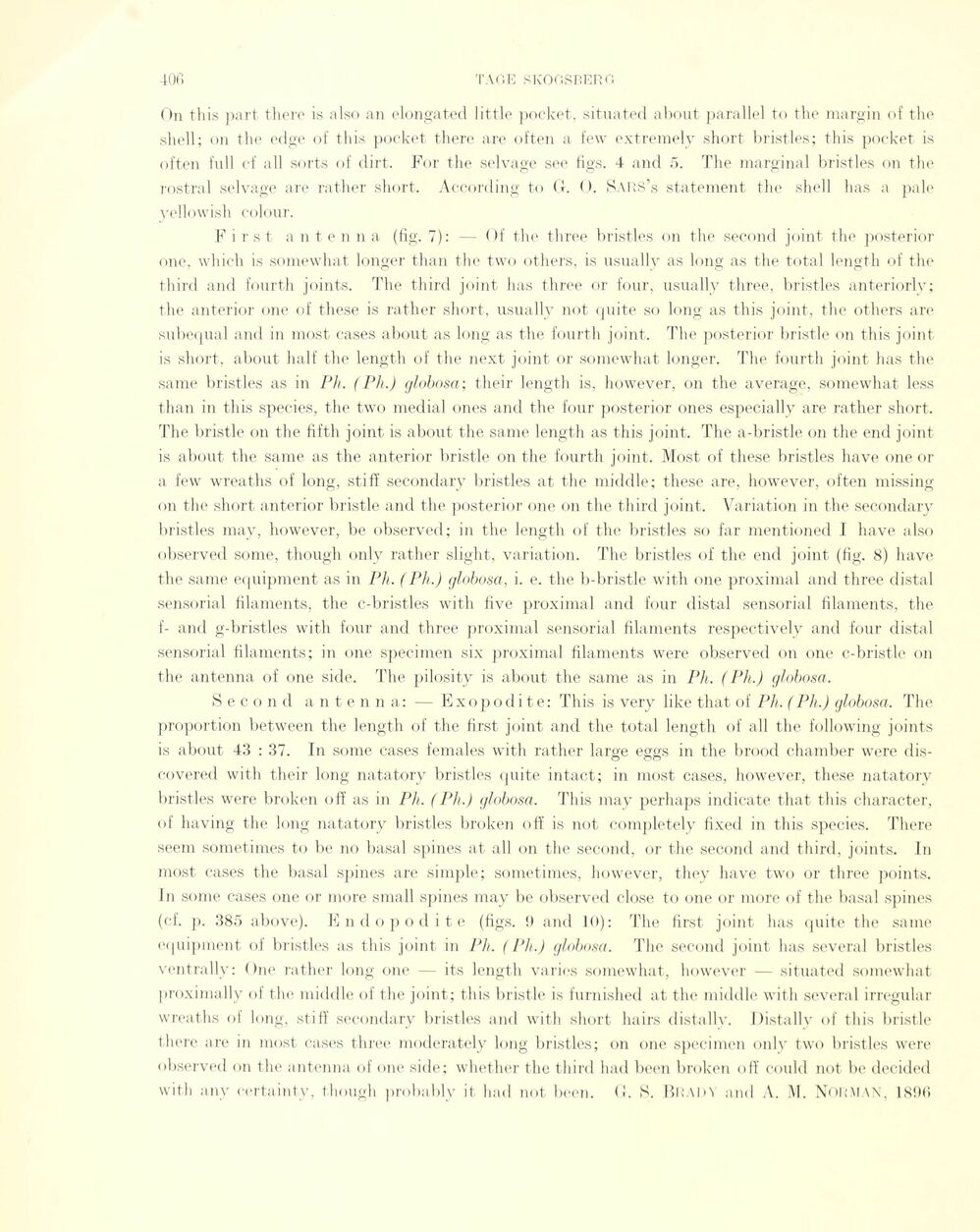
Full resolution (JPEG) - On this page / på denna sida - Sidor ...

<< prev. page << föreg. sida << >> nästa sida >> next page >>
Below is the raw OCR text
from the above scanned image.
Do you see an error? Proofread the page now!
Här nedan syns maskintolkade texten från faksimilbilden ovan.
Ser du något fel? Korrekturläs sidan nu!
This page has never been proofread. / Denna sida har aldrig korrekturlästs.
On this part there is also an elongated little pocket, situated about parallel to the margin of the
shell; on the edge of this pocket there are often a few extremely short bristles; this pocket is
often full cf all sorts of dirt. For the selvage see figs. 4 and 5. The marginal bristles on the
rostral selvage are rather short. According to G. O. Sars’s statement the shell has a pale
yellowish colour.
First antenna (fig. 7): — Of the three bristles on the second joint the posterior
one, which is somewhat longer than the two others, is usually as long as the total length of the
third and fourth joints. The third joint has three or four, usually three, bristles anteriorly;
the anterior one of these is rather short, usually not quite so long as this joint, the others are
subequal and in most cases about as long as the fourth joint. The posterior bristle on this joint
is short, about half the length of the next joint or somewhat longer. The fourth joint has the
same bristles as in Ph. (Plu.) globosa; their length is, however, on the average, somewhat less
than in this species, the two medial ones and the four posterior ones especially are rather short.
The bristle on the fifth joint is about the same length as this joint. The a-bristle on the end joint
is about the same as the anterior bristle on the fourth joint. Most of these bristles have one or
a few wreaths of long, stiff secondary bristles at the middle; these are, however, often missing
on the short anterior bristle and the posterior one on the third joint. Variation in the secondary
bristles may, however, be observed; in the length of the bristles so far mentioned I have also
observed some, though only rather slight, variation. The bristles of the end joint (fig. 8) have
the same equipment as in Ph. (Ph.) globosa, i. e. the b-bristle with one proximal and three distal
sensorial filaments, the c-bristles with five proximal and four distal sensorial filaments, the
f- and g-bristles with four and three proximal sensorial filaments respectively and four distal
sensorial filaments; in one specimen six proximal filaments were observed on one c-bristle on
the antenna of one side. The pilosity is about the saine as in Ph. ( Ph.) globosa.
S e c o n d antenna: — Exopodite: This is very like that of Ph. (Ph.) globosa. The
proportion between the length of the first joint and the total length of all the following joints
is about 43 : 37. In some cases females with rather large eggs in the brood chamber were
dis-covered with their long natatory bristles quite intact; in most cases, however, these natatory
bristles were broken off as in Ph. ( Ph.) globosa. This may perhaps indicate that this character,
of having the long natatory bristles broken off is not completely fixed in this species. There
seem sometimes to be no basal spines at all on the second, or the second and third, joints. In
most cases the basal spines are simple; sometimes, however, they have two or three points.
In some cases one or more small spines may be observed close to one or more of the basal spines
(cf. ]). 38f> above). En dopod i te (figs. 9 and 10): The first joint has quite the same
equipment of bristles as this joint in Ph. (Ph.) globosa. The second joint has several bristles
ventrally: One rather long one — its length varies somewhat, however — situated somewhat
proximally of the middle of the joint; this bristle is furnished at the middle with several irregulär
wreaths ot long, stiff secondary bristles and with short hairs distally. Distally of this bristle
there are in most cases three moderately long bristles; on one specimen only two bristles were
observed on the antenna of one side; whether the third had been broken off could not be decided
with any certainty, though probably it had not been. G. S. Bhady and A. M. NORMAN, 1896
<< prev. page << föreg. sida << >> nästa sida >> next page >>